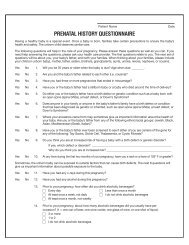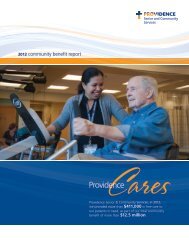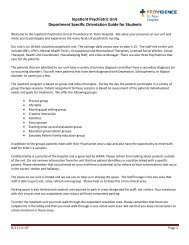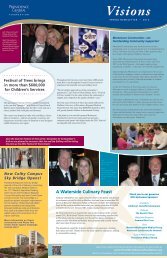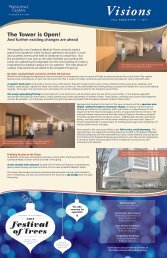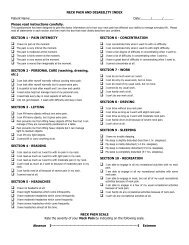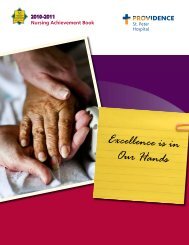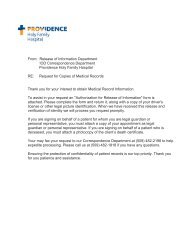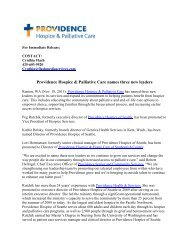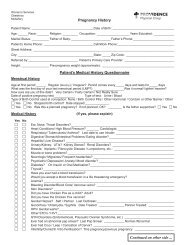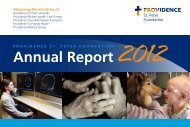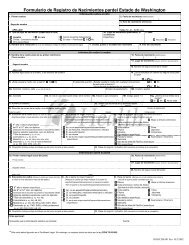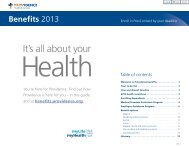Issue 3 - Fall - Providence Washington - Providence Health & Services
Issue 3 - Fall - Providence Washington - Providence Health & Services
Issue 3 - Fall - Providence Washington - Providence Health & Services
- No tags were found...
Create successful ePaper yourself
Turn your PDF publications into a flip-book with our unique Google optimized e-Paper software.
“I’m eternally grateful that he [my husband] wasthere, but I also think this is a great reminderthat anyone can learn CPR.” —Dr. Tuttlecontinue with my running scheduleas well—and I was just totallyexhausted.”Besides fatigue, other issuessurfaced: “On my return trip fromIndia, I passed out on the plane, andwhen I got home, I noticed my feetwere swollen. I thought it was dueto being dehydrated or spending toomuch time sitting on long internationalflights.”In reality, those episodes—combinedwith her exhaustion—couldhave been indicators that somethingwas not right with her heart. Afterall, a heart condition called hypertrophiccardiomyopathy runs in herfamily. It causes a thickening of theheart muscle and is a leading causeof sudden cardiac death.The Day her heart stoppedAt 2 a.m. on Easter, Dr. Tuttle’s husband,Andy Boulet, MD, was awakenedby a massive seizure takingcontrol of his wife’s body.“As a spouse, I felt really bad forher and what she was experiencing,”he says. “And as a physician, I wasterrified about all the things thatcould be making this happen.”When her seizure stopped, hecould find no pulse. But after hegave her CPR for five minutes, herpulse returned and she began toregain consciousness.She returned to normal butagreed to go to the emergency roomfor evaluation. The pair soon beganthe 20-minute drive toward <strong>Providence</strong>Sacred Heart Medical Center& Children’s Hospital. Dr. Tuttleapologized to her husband for the“inconvenience,” then commentedthat she felt lightheaded.It was the last thing she saidbefore she went into sudden cardiacdeath again.“I felt her pulse stop,” Dr. Bouletsays. “I called 911 and hit thegas rather than stopping, becauseI had to get out to the main roadwhere paramedics would find usmore easily.”After learning it would take20 minutes for help to arrive, Dr.Boulet pulled his wife out of the carand laid her on the asphalt, wherehe began chest compressions again.“It upset me to know the paramedicswere that far away. I knewthat it wasn’t good for Kathy’s chanceof survival, or for her outcomes ifshe did survive. I also knew the CPRguidelines had changed and wasthinking that they better be right!”He knew what he was up against.“Literature shows that 20 minuteswithout oxygen to the brain is reallypushing it. I was grieving aboutwhat was probably going to happento my wife, while trying to keep mycool as a professional and do whathad to be done.”He did chest compressions onhis lifeless spouse for 19 minutesbefore paramedics arrived and useda defibrillator to shock her heartinto action. A second shock restoredTuttle’s pulse, but she still did notregain consciousness.Beating the OddsAt the hospital, Sacred Heart’sexpert team rushed into action,running tests and ultimately decidingto begin a cooling protocolbecause she still wasn’t conscious.This process of cooling the body isan effort to protect the vital organsfrom suffering permanent damagebecause of lack of oxygen. All in all,cooling and then warming the bodyagain takes about 36 hours. Andthen begins the waiting to see howthe patient will wake up—whethershe will be alert and whether shewill recognize anyone.For Dr. Boulet, it was a gruelingtime of wondering whether hisamazing wife would be left with significantdisabilities. And would sheknow her own husband and their16-year-old daughter?At last, Dr. Tuttle awoke and aneurologist began to ask her questions.He pointed at Dr. Boulet andasked the patient if she knew whohe was.26 ● <strong>Fall</strong> 2012 Heart Beat



